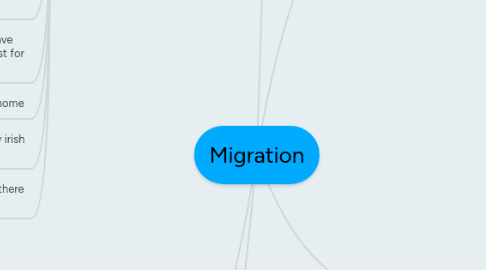Migration
by maggie raedeke

1. why do people migrate
1.1. the distinction between forced and voluntary is not always clear cut.
1.2. push factors include: work, cost of living, personal safety.
1.3. studies of gender and migration show that men are more mobil than women.
1.4. the key difference between voluntary and forced migration however is that voluntary migrants have an option at the very least, where to go and what to do there forced migrants do not.
1.5. the largest forced migration in the history of humanity was the atlantic slave trade.
1.6. forced migration still happens today. it continues to occur in which governments detain migrants who enter countries illegally
1.7. since 1989 the United states has interdicted detained and returned illegal haitians migrants.
1.8. every migration flow generates a return or countermigration
1.9. the majority of migrants move a short distance
1.10. migrants who move longer distances tend to chose big city destinations
1.11. urban residence are less migratory than inhabitants of rural areas
1.12. families are less likely to make international moves than young adults
1.13. the gravity model assumes that spatial interactions is directly related to the population.
1.14. a migrants decision of where to go emigrants from home country and migrate to a new country results from a combination of push and pull factors
1.15. pull factors tend to be vaguer and may depend solely on perceptions constructed on ideas of a place.
1.16. having a visa makes you a legal migrant because you have your documents to show your legal right to be there.
1.17. poverty has driven countless millions from their homelands and continues to do so.
1.18. migrants can arrive in a country with or without content from host family.
1.19. empoyers who hire migrant workers often have perception of what kinds would work the best for them.
1.20. war often drives people from there home
1.21. the potato blight caused many irish families to immagrate
1.22. people migrate to preserve there culture and traditions
2. where do people migrate
2.1. european explorers played a large role in mapping the world.
2.2. many europeans moved to the newly colonized places.
2.3. migrants go to neighboring countries to tai advantage of short-term economic opportunities.
2.4. if we study flow at only a global scale, we see migrants moving from one poor country to another poor country
2.5. regional migration flows also center on reconnecting cultural groups across borders.
2.6. russia had mojor internal migration every one moved east.
2.7. westerner european governments called he labor migrants guest workers.
2.8. when the need for labors decline destination governments can squeeze out guest workers.
2.9. the worlds refugees population has grown steadily steadily since 1951.
2.10. when a refugee meets the official criteria they become eligible for asistance including possible asylum.
3. how do goverenments afffect migration
3.1. typically the obstacles placed in the way of potential immigration are legal not physiacl
3.2. changes in a countries migration policies are refeclted in the number of people entering the country and the origin of the immigrants.
3.3. during the 1800s the us opened its doors to immigrants.
3.4. many countries practice selective immigrationn in which individuals with certain backgrounds are barred from entering.
3.5. since september 11 2001 immigration policies have incorporated security concerns.
3.6. migration will continue to shape security polices in the u.s for decades to come.
4. field note
4.1. Across the world hundreds of thousands of of migrants have fled their homelands by boat, train, car or foot in North America, Australia, and China.
4.2. As long as imigants perceave better life abroad they will continue to migrate.
4.3. of estitimated 31.2 million immigrants in the us 20.4 are legal immigrants.
5. what is migration
5.1. human movent speeds diffusion of ideas and innovations
5.2. mobility ranges from local to global- from daily to once in a life time.
5.3. cyclic movement starts at our home base and brings us back to it.
5.4. the average american commuter travels a greater distance in a day than they average chinnese villager does in a year.
5.5. a common type of perodic movement is migrant labor.
5.6. people move with there live their during different seasons this is called transhumance
5.7. when movement resaults in permanet relocation it is called migration
5.8. when one leaves there home country they are classifed as a emigrant.
5.9. when one enters a new cuntry they are an immigrant
5.10. internal migration varies according to the moblitlity of the population.


